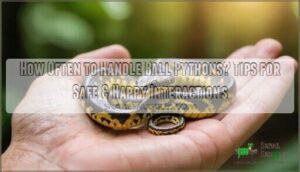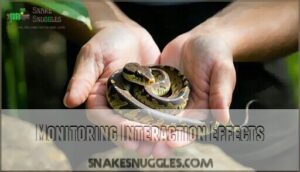This site is supported by our readers. We may earn a commission, at no cost to you, if you purchase through links.
 You should handle your ball python 1-3 times a week, depending on its comfort and routine.
You should handle your ball python 1-3 times a week, depending on its comfort and routine.
Too much handling can stress them out, while too little might make them less social.
Avoid handling right after feeding—no one likes being poked with a full belly—and give them a couple of days to digest.
Younger snakes may tolerate handling more often, but always watch for signs of stress, like hissing or trying to hide.
Think of it like visiting a friend: enough to keep the bond strong, but not so much that it feels like an invasion, and remember balance is key for happy interactions, to maintain a strong and healthy relationship!
Table Of Contents
- Key Takeaways
- How Often to Handle Ball Pythons?
- Handling Frequency Guidelines
- Factors to Consider
- Acclimation Period Importance
- Signs of Stress in Ball Pythons
- Adjusting Handling Routine
- Frequently Asked Questions (FAQs)
- How often should you handle a ball python?
- How often should you feed a ball python?
- Can a ball python be handled too much?
- How should I handle a ball python?
- How do you care for a ball python?
- Should you wash your hands after handling a ball python?
- How often should you handle your ball python?
- Is it okay to hold my ball python during the day?
- How long until I can handle my ball in python?
- How to tell if a ball python is stressed?
- Conclusion
Key Takeaways
- Handle your ball python 1-3 times a week for 15-20 minutes to build trust while avoiding stress.
- Skip handling during shedding or within 48-72 hours after feeding to prevent discomfort or regurgitation.
- Watch for stress signs like tight coiling, hissing, or refusing food, and adjust your routine accordingly.
- Always approach calmly, support its body fully, and wash your hands before and after handling.
How Often to Handle Ball Pythons?
Handling ball pythons is all about balance. Aim for a handling frequency of 1-3 times a week, keeping each session duration around 15-30 minutes.
Handle ball pythons 1-3 times weekly for 15-30 minutes to build trust while keeping your snake comfortable and stress-free.
This helps with building trust and keeps your snake comfortable. Avoid handling during the 48 hours after feeding to prevent regurgitation, and skip sessions if your snake shows stress signs like coiling tightly or refusing food.
Younger snakes may need less interaction since they’re more defensive. Always wash your hands before and after handling to keep things clean and safe.
Remember, avoiding overhandling is key—too much attention can stress your snake. Start slow, observe its reactions, and let the bond grow naturally.
Handling Frequency Guidelines
In terms of snake handling frequency, balance is key. Ball pythons thrive with weekly handling 1-3 times, keeping sessions around 15-20 minutes. Overdoing it can stress them out, while too little interaction might miss out on building trust and familiarity.
Stick to these snake handling frequency guidelines:
- Limit handling to 3-4 times weekly, with no more than one session per day.
- Always wait 48-72 hours post-feeding to prevent regurgitation.
- Avoid handling during shedding, as snakes are often irritable then.
Pay attention to individual needs—some snakes are social, while others prefer minimal interaction. To make certain of proper nutrition, consider the importance of selecting the correct prey for your ball python. Use slow, steady movements, support their body fully, and keep the environment quiet. By following these tips, your ball python will stay healthy, happy, and stress-free during handling sessions.
Factors to Consider
When deciding how often to handle your ball python, you’ll need to think about its age, feeding schedule, and temperament.
Each snake is unique, so paying attention to these factors will help keep your pet healthy and stress-free.
Age
Ball pythons’ handling needs shift as they age. Hatchlings are delicate, so limit handling to let them grow stress-free. For juveniles, gentle interaction helps them adjust, but don’t overdo it.
Adults are usually more relaxed, making them ideal for calm, regular handling sessions. Senior snakes, however, may need extra care due to potential sensitivity.
| Age Group | Handling Frequency | Key Considerations |
|---|---|---|
| Hatchlings | Minimal, once a week max | Fragile, prioritize development |
| Juveniles | 1-2 times weekly | Gentle, avoid stress |
| Adults | 3-4 times weekly | Docile, enjoy calm interactions |
| Seniors | Case-by-case basis | Sensitive, adapt to health needs |
Respect their lifespan considerations to guarantee safe, happy handling!
Feeding Schedule
A ball python’s feeding schedule plays a big role in planning handling sessions.
To avoid stress or regurgitation risks, give your snake proper digestion time after meals. Typically, wait 48-72 hours post-feeding before handling. Also, avoid handling right before feeding, as it may disrupt their appetite.
Keep these factors in mind:
- Feeding frequency impacts digestion needs.
- Prey size affects how long digestion takes.
- Food type can influence handling timing.
To encourage eating, consider that warming pre-killed prey can enhance its scent and appeal.
Temperament
Ball python temperament varies widely, with some being naturally calm and others more defensive.
Younger snakes might coil or hide their heads, showing lower handling tolerance. Larger ones, though docile by nature, need careful support.
Watch for stress signals like hissing or tight coiling. Consistent, gentle handling builds trust and reduces defensive behaviors, but always respect individual personalities and adjust snake handling frequency advice accordingly, considering the importance of respect.
Acclimation Period Importance
When bringing your ball python to a new home, it’s normal for them to feel stressed. This period, known as acclimation, is key to their comfort and health.
Give your ball python time to settle in—patience during acclimation builds trust and ensures a stress-free start in their new home.
Rushing into handling can upset their routine, so focus on creating a secure enclosure first. Here’s a simple plan:
- Initial Handling Avoidance: Wait 1-2 weeks before handling, giving your snake time to settle.
- Eating Before Handling: Confirm they’ve eaten at least once in their new home to confirm they’re adjusting.
- Gradual Introduction Time: Start with short, calm interactions after the acclimation period.
To confirm your snake is healthy, consider that quarantine prevents disease before introducing it to other reptiles. Patience pays off—letting your snake feel safe builds trust for smoother handling later.
Signs of Stress in Ball Pythons
Understanding when your ball python is stressed helps you adjust your handling routine to keep it comfortable.
By watching for signs like tight coiling or refusing food, you can guarantee your interactions don’t overwhelm your snake, which is crucial for maintaining its well-being and ensuring a positive relationship between you and your ball python.
Body Language Cues
Understanding snake body language helps you spot stress signals early.
Watch for these signs:
- Defensive Behaviors: Tight coiling or hiding its head shows discomfort.
- Tongue Flicking: Rapid, frequent flicks may indicate anxiety.
- Hissing: A clear warning that your python feels threatened.
- Strike Threats: Mock strikes or sudden movements signal marked unease.
Relaxed postures, like smooth movements and gentle exploration, mean your snake feels safe.
Always adjust handling to avoid triggering these stress signs.
Providing adequate secure hiding places can substantially reduce stress.
Health Issues
If your python shows wheezing, nasal discharge, or labored breathing, it could mean respiratory infections.
Refusing food or regurgitation? Stress or overhandling might be the culprit.
Watch for scale rot, mites, or irregular shedding—these signal poor snake health.
Here’s a quick guide:
| Issue | Possible Cause |
|---|---|
| Regurgitation | Handling post-feeding |
| Scale Rot | Damp bedding |
| Respiratory Issues | Stress, poor hygiene |
| Mite Infestations | Contaminated enclosures |
| Obesity Prevention | Overfeeding |
Adjusting Handling Routine
Your ball python’s comfort should guide how often you handle it, as each snake has unique needs and preferences.
By watching for signs of stress or relaxation, you can adjust your routine to keep interactions safe and enjoyable.
Based on Snake’s Needs
Pay attention to your snake’s individual temperament and activity levels when planning handling sessions.
Avoid handling during shedding sensitivity or right after meals to prevent stress.
Balance interaction with rest by observing their enclosure environment and behavior.
Watch for snake stress signs like hiding or coiling tightly.
Tailor handling frequency to their health considerations and individual preferences for a happy, relaxed pet.
Monitoring Interaction Effects
To monitor handling effects, focus on your snake’s comfort and behavior.
Watch for stress level signs or behavioral changes observed.
Adjust your routine to promote long-term wellbeing:
- Handle during active hours for better response.
- Limit sessions to 15-20 minutes.
- Use calm, steady movements to reduce stress.
- Regularly assess the handling impact and tweak interactions as needed.
Frequently Asked Questions (FAQs)
How often should you handle a ball python?
Handle your ball python 1-3 times a week, keeping sessions under 20 minutes.
Avoid handling during shedding or within 48-72 hours after feeding.
Watch for stress signs, and always prioritize your snake’s comfort and health.
How often should you feed a ball python?
Think of feeding as a rhythm.
Younger ball pythons eat every 5-7 days, while adults prefer a meal every 10-14 days.
Always match prey size to their girth, and avoid overfeeding—it’s key!
Can a ball python be handled too much?
Yes, handling a ball python too much stresses it out.
Overhandling can lead to health issues, defensive behavior, or feeding problems.
Stick to 1-3 times weekly, keeping sessions under 20 minutes to avoid overwhelm.
How should I handle a ball python?
Approach slowly, stay calm, and support your ball python’s body fully.
Keep sessions short, around 10-20 minutes.
Avoid sudden movements, handling after feeding, or during shedding.
Let the snake explore freely while you remain patient.
Avoid handling after feeding, or during shedding.
How do you care for a ball python?
Provide a warm, secure enclosure with proper heat, humidity, and hiding spots.
Feed appropriately sized prey every 7-10 days.
Handle gently, avoiding shedding or digestion periods.
Regularly clean the habitat and monitor health signs.
Should you wash your hands after handling a ball python?
Handling a ball python is like shaking hands with nature, but always wash up afterward.
It keeps germs at bay, protects both you and your snake, and guarantees a clean, healthy interaction every time.
How often should you handle your ball python?
Handle your ball python 1-3 times a week, keeping sessions under 20 minutes.
Avoid handling after feeding, during shedding, or if it seems stressed.
Gradually increase frequency as your snake becomes more comfortable.
Is it okay to hold my ball python during the day?
Yes, you can hold your ball python during the day, but keep sessions short, around 15-20 minutes.
Avoid handling if it’s shedding, stressed, or digesting food, as these times can cause discomfort.
How long until I can handle my ball in python?
Wait at least two weeks after bringing your ball python home before handling it.
Give it time to settle, eat, and feel secure.
Rushing this can stress your snake and delay its adjustment.
How to tell if a ball python is stressed?
A stressed ball python might curl tightly into a ball, hide its head, or hiss.
Look for tail whipping, striking, or refusing food.
Slow movements and tongue flicking usually mean it’s feeling calm.
Conclusion
Think of handling your ball python like tuning a musical instrument—too much or too little disrupts harmony.
Handling them 1-3 times a week strikes the right balance, keeping them social without causing stress.
Pay attention to their age, feeding schedule, and temperament to adjust your routine.
Watch for signs of stress, like hiding or hissing, and always let their behavior guide you to build a strong bond over time.
- https://www.academia.edu/34449936/Animal_handling_techniques_snakes_totoise_and_small_birds
- https://iaabcjournal.org/enrichment-for-snakes/
- https://www.quora.com/How-often-and-how-much-should-one-feed-a-Ball-Python
- https://kinovareptiles.com/2024/03/13/the-ultimate-ball-python-care-guide/
- https://ball-pythons.net/forums/showthread.php?243687-Ball-Python-Feeding-Guidelines/page3













